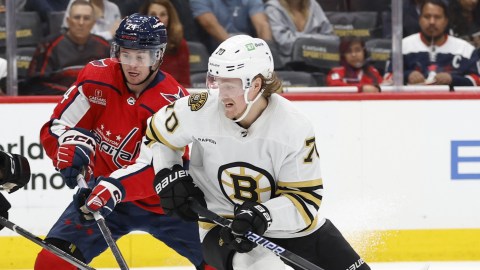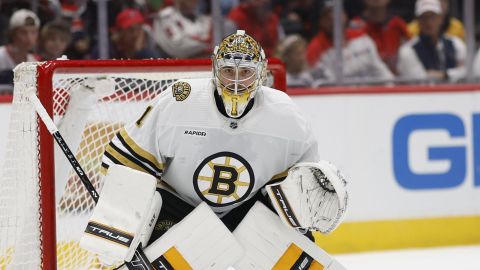The Boston Bruins’ return to the Stanley Cup playoffs will be exciting just for being the Black and Gold’s first postseason foray since 2014.
But as for the games themselves, Bruins fans should brace for a deliberate and sometimes frustrating pace against an Ottawa Senators team that stymied the B’s this season.
(You’ll want to keep the term “chess match” out of your Bruins-Senators drinking game unless you want to end up streaking down to the quad by yourself.)
Boston went winless in four attempts against Ottawa this season, scoring just a combined six goals in those games. Guy Boucher’s team had plenty of success containing the B’s by doing what it tries to do every night: slowing down the game.
Boucher led the Tampa Bay Lightning to within one game of the Stanley Cup Final in 2011 thanks in large to the 1-3-1 neutral-zone trap, the same strategy he’s used to have success with the Sens. It was the Bruins, of course, who kept Boucher and the Lightning from the Cup Final with a 1-0 win in a Game 7 classic on their way to winning the Cup.
Boston will need a similar effort this time around. This Senators team isn’t as good as that Lightning team, much like these Bruins don’t equal the 2011 club. But the strategy — and how Boston attacks the 1-3-1 — will be similar.
Here’s what the Bruins need to do to solve Ottawa’s neutral-zone system and ultimately win the series.
SCORE FIRST
Obviously, any team wants to score first. But it’s even more important for Ottawa, as getting the game’s first tally allows the Sens to set up the 1-3-1 and really slow down the game. The Senators were 29-6-3 when they scored first this season. When they score first, they dictate the play. When you score first, though, you put Ottawa on its heels. The Sens were just 15-22-7 when their opponent scored first, and they don’t have the offensive firepower (2.51 goals per game, 22nd in NHL) to dig out of holes.
MAKE THE POWER PLAY COUNT
Really the best way to render the 1-3-1 ineffective is to take away Ottawa’s ability to use the strategy altogether, making the power play of incredible importance to Boston. The Bruins scored a power-play goal in each of their four games with Ottawa this season, and five of the six goals they scored overall came on the man advantage. Ottawa’s penalty kill was nothing special, ranking 22nd in the NHL.
BREAK OUT CLEAN, BREAK OUT FAST
Breakouts are going to be as important as ever for the Bruins, which is where the potential loss of a player like Torey Krug — Boston’s best puck-moving defenseman — might hurt the most. If the Bruins are able to sneak the puck up the ice before Ottawa can set its defense, Boston will have odd-man opportunities.

In the screenshot above, you can see Ryan Spooner flying up the middle of the ice as Ottawa scrambles to retreat.

This isn’t the look Ottawa wants. The Senators want to be waiting for the play to come to them, not reacting. Spooner has a head of steam and is flanked on both sides. The Bruins are the ones dictating the pace here.
 The end result for the Bruins is having numbers into the neutral zone, which leads to a scoring chance. Not only that, but the Bruins are then able to keep the puck in the Ottawa zone, where they’re able to establish possession and get into their offense.
The end result for the Bruins is having numbers into the neutral zone, which leads to a scoring chance. Not only that, but the Bruins are then able to keep the puck in the Ottawa zone, where they’re able to establish possession and get into their offense.
STICK WITH THE PLAY AND THE FORECHECK
Take a look at the screenshot below, where the Senators — aided by a Bruins line change — are able to create traffic in the neutral zone.

However, the Bruins — spearheaded by Patrice Bergeron, of course — are able to stick with the play and follow up on the dump-in into the Ottawa zone.

Bergeron (above, circled) sticks with the play and harasses the Senators on the forecheck. Bergeron’s harassment forces Mark Stone into a bad decision, as he tries to reverse the puck back through the middle, which turns out to be a bad idea. David Backes (above, starred) reads the play and barrels into the offensive zone to break up the pass and set up an offensive chance for Boston.
DO THE DIRTY WORK
Sometimes, you have to take a hit to move the puck.

In the shot above, Bruins defenseman Zdeno Chara has two teammates streaking up the middle for an outlet pass. As mentioned earlier, moving the puck quickly up the ice takes away Ottawa’s ability to set up the trap, as evidenced by three players on the Boston end of the blue line.

Noel Acciari (circled) is accustomed to giving big hits. Here, however, he’s on the receiving end, but it’s a play he has to make. He goes to the middle of the ice and is able to move the puck despite taking a huge hit at center ice. That allows the Bruins to get through the neutral zone with speed despite the speed bump.

Similar to the big man coming to the middle of the court to break a full-court press in basketball, Acciari’s selflessness sets up the “press break” and allows Dominic Moore to enter the zone with the puck with Riley Nash close behind with speed.

The end result is Nash (circled) going to the net to create traffic, while Moore (squared) has already gone to the center of the ice and found the trailing defenseman, Brandon Carlo, who jumped into the play with a relatively open shooting lane and traffic in front. Even Acciari is back in the play, and the Bruins were able to establish a lengthy possession in the Ottawa zone. Game plan.
FINISH.
The Bruins, despite all the talk about Ottawa keeping them quiet offensively, averaged 28 shots on goal per game against the Senators. The Bruins were swept by Ottawa, sure, but they had their chances. If they’re able to finish those chances (an admittedly familiar refrain in Bruins circles over the years), they can win this series.
EXECUTE.
There are going to be times when Ottawa is able to set up the trap to perfection. It’s going to be frustrating. There are just so many layers that even if you beat it in the neutral zone, there’s another wave waiting at the blue line, allowing the other Senators to retreat and rejoin the play. But if the Bruins stick to the plan, and they get pucks deep, get in on the forecheck and establish possession in Ottawa’s zone, they’ll have their chances.
Or, you know, they could just do this.
Being able to thread the needle in all three zones certainly would help.
This obviously isn’t the same Bruins team from six years ago, but there are enough players, coaches and personnel left over to know they can get through this challenge — as boring as it might be at times.
Screenshots via NHL.TV
Thumbnail photo via Bob DeChiara-USA TODAY Sports Images




